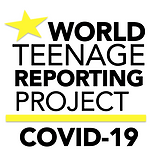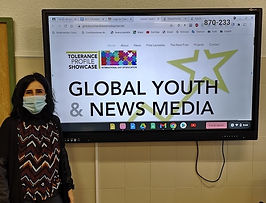

Global project became a class project for this teacher in Spain

Teenage journalists received certificates commemorating their acceptance into the World Teenage Reporting Project. From left they are, Arianna Berche Carranza, Helena González Velasco, Meriem Rouidjali Adoul, Yassin Samoue Chafik, Leticia Montserrat (Montse) Jiménez Quizhpi and Cristina López Lusarreta.
When English teacher Araceli López Martinez heard from her former colleague about a World Teenage Reporting Project that called on teenage journalists to profile champions of tolerance, she knew right away what she was going to do.
Six of her students worked in groups and individually to produce three profiles of such champions: an activist fighting the misuse of parking spaces intended for handicapped people, an inspirational advocate of how education helped a girl get ahead, and a specialist in neuropsychology who helps schools better integrate pupils who have a different kind of thinking.
“The stories in one way or another are close to them and they wanted to share them,” Araceli said.
OUT OF COMFORT ZONE
Student journalist Meriem Rouidjali Adoul profiled Juan Larreta, who works to raise awareness about the parking space issue. She says it was good to “step out of my comfort zone” and try a new kind of writing. “I thought this topic had a lot to offer,” she said. “I stand by the phrase ‘live and let live’ as the basis of liberty and of tolerance. [As a daughter born in Spain to Algerian parents], I've dealt with my share of having to be tolerant and maybe tolerated too.”
Leticia Montserrat (Montse) Jiménez Quizhpi and Cristina López Lusarreta worked together to profile counselor Raquel Pascual Echeverría about new thinking in both how brains work and how best to support those differences in schools.
“We want to change the world or, at least, contribute to it and, what better way than to start from [some] of the most unnoticed yet vulnerable people?,” they wrote to explain why they chose that topic. “They are classified as [having] ‘living disorders’ because their brain isn't like most people's and, they have no choice but to live in a world that was not meant for them, in a society that's fine without them. We might not change everyone's life but, we're determined to make some room in our world to fit different brains, to give them an opportunity to live. We want to change their world, that's why we're here.”
For Yassin Chafik, the story was very close to home. Together with Helena González Velasco and Arianna Berche Carranza, Yassin Somoue Chafik profiled his mom. “We thought that her story was very interesting and was very valuable and so it was worth writing about her,” he explained.
THe purpose? AMPLIFY & ACQUAINT
This is the second World Teenage Reporting Project organized by Global Youth & News Media, a France-based nonprofit dedicated to encouraging connections between young people (children and teenagers) and news media.
The first edition in the spring of 2020 focused on filling a gap in the coverage of COVID-19 with 60 stories about how teenagers were helping during the pandemic, produced by teenage journalists in 19 countries. The main media partner for both projects was News-Decoder, also based in France, global educational news service that also helps schools directly to fulfill their mission to create better global citizens.
“As for the first edition of the project, our key goals are to amplify both reporting by teenage journalists as well as the choices they make about who and what is newsworthy to them,” said Dr. Aralynn McMane, Global Youth & News Media director. “While we don’t instruct the students or edit the stories ourselves, we also believe that the process of doing those stories helps students learn something about how solutions journalism works, especially if they do the follow-up activity and do an additional edit of their stories.”
Indeed, the assignment forced students to do a lot of their own learning about doing journalism. Yassin explained that while they got help at first with general information, the teacher then “disappeared [in order to] see our progress as if we were alone, [how we] walked in a bigger world, dealing with technical problems, deadlines, using computers for a good purpose and getting closer to an unknown world for us.”
As Araceli takes a hiatus to study for the exams that will add to her teaching qualifications, her students will be busy with that follow-up activity. They will rewrite their stories in a journalistic style with the help of some guidance from Global Youth & News Media and from veteran English teacher and writing coach, Jose Javier Baile, who originally alerted Araceli to the project.
